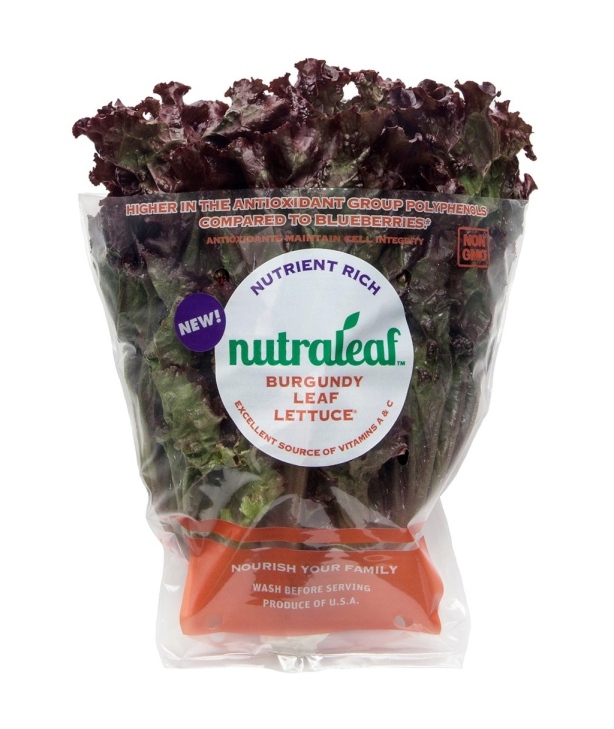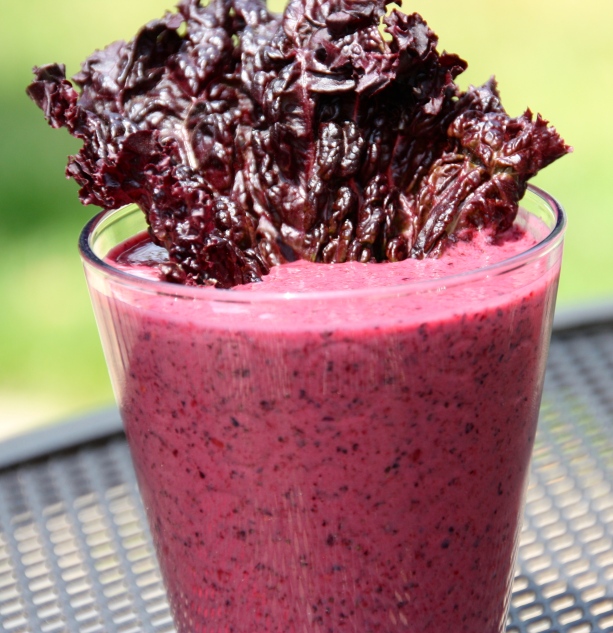Lettuce is one of the oldest known vegetables, native to the Mediterranean region, and thought to have been cultivated for nearly 5,000 years. Apparently Pharaoh was quite fond of the leafy green as homage was paid to him and lettuce in paintings found on the walls of ancient Egyptian tombs.
Romaine lettuce was one of the first lettuce varietals introduced to the United States, from England, in the 1600’s. Though it is the second most consumed vegetable in the United States today, lettuce gets a bad rap as just being a gateway vegetable for dressing. At best, it’s credited with making other vegetables tolerable. But finally, lettuce, thanks to researchers at Rutgers University, lettuce has finally come into its own.
Ilya Raskin, Distinguished Professor at Rutgers, and his team of researchers started with regular red lettuce as parent stock and then bred the darkest strains to create new deep purple leaf and Romaine varietals, which they call RSL (Rutgers Scarlet Lettuce), now branded by Coastline Family Farms in Salinas California as Nutraleaf Burgundy Leaf Lettuce and Romaine™. Coastline is introducing the new lettuces to the produce industry at the Produce Marketing Association’s Fresh Summit conference in Anaheim, CA, where 30,000 retail, foodservice and produce representatives gather. They will also introduce it to over 8,000 registered dietitians at the 2014 FNCE conference in Atlanta.

Dave out standing in his (actually Coastline’s) field…
The lettuces were developed, through natural breeding processes to contain higher levels of the antioxidant group polyphenols and anthocyanins – twice as high, based on phytochemical analyses, when compare to blueberries. Nutraleaf Burgundy Leaf Lettuce™ and Nutraleaf Burgundy Romaine™ are nutrient rich at only 20 calories per 2 cup serving, are an excellent source of vitamins A and C and the mineral manganese, and a good source of fiber. The Nutraleaf Leaf Lettuce is also a good source of iron and potassium.
Rutgers, who received partial funding for their research from the National Institutes of Health, has also been studying the impact of the new lettuces on health parameters. They have published one paper on their work in the prestigious scientific journal PLOS ONE and in the journal Nutrition. In this animal study, blood glucose was lowered in the intervention group that consumed RSL, which the authors attributed to the properties of the polyphenols found in RSL. In another animal study, just completed and awaiting publication, the Rutgers group also found positive effects on genetically obese mice. A European group is conducting a human nutrition study to document this benefit.
But what is great nutrition without outstanding taste and enjoyment? I think you will be thrilled with these yummy recipes I developed working with Coastline Family Farm’s for their Nutraleaf lettuces launch. Definitely try out my “Purple Reign” smoothie recipe. Are you digging the Prince references?
Ingredients:
Burgundy lettuce -6 leaves (1 cup)
Welch’s blackberry juice 1 cup
1 strawberry lite Greek yogurt (5.3oz)
1 cup frozen mixed berries
Directions:
Wash and pat dry lettuce leaves and place in a blender. Add remaining ingredients and blend until smooth. Serve with a lettuce garnish.

Grilled Mixed Veggies with Watermelon BBQ Reduction
Servings: 4
BBQ Reduction:
2 tablespoons Balsamic
2 tablespoons honey
2 tablespoons mixed berry preserves
3/4 cup watermelon juice
4 chopped prunes
½ cup frozen mixed berries
2 teaspoons tamari sauce
1-teaspoon dijon mustard
¼ teaspoon smoked paprika
2-tablespoons ketchup
Grilled mix
16 California Strawberries
1 cup purple cauliflower
2 medium Vidalia onions, quartered
1 red pepper, cut in 8 pieces
1 yellow pepper, cut into 8 pieces
4 ¼ inch slices of pineapple
8 purple fingerling potatoes , sliced in half
Dressing
2 tablespoons Olive oil
1 tablespoons Balsamic vinegar
1 tablespoon Honey
¼ teaspoon Italian seasoning
¼ tsp salt
¼ tsp black pepper
Directions:
BBQ Reduction:
Cut up watermelon pieces and place in a fine mesh strainer. Place strainer over a glass measuring cup. Press watermelon pieces with a spoon and express out enough juice to yield ½ cup. Pour juice into a saucepan. Mix in all remaining ingredients. Bring to boil over a medium heat. Reduce heat and cook reduction down to a BBQ sauce consistency (about 20 minutes). Stir frequently. Set aside.
Grilled Mix:
Preheat grill. Place fingerlings in a microwavable bowl and heat on high for two minutes. Set aside. Place whole strawberries on their own skewer with four on each skewer. Skewer remaining vegetables, including fingerlings, on their own skewer. Brush all skewers lightly with canola oil. When grill is hot, place skewers on the grill. Cook until grill marks are apparent on all sides. Remove strawberries once grill marks occur (just a few minutes). Brush BBQ sauce on remaining skewers and grill until veggies are soft. Set aside.
Salad:
Mix ingredients of dressing together. Set aside. Lay Burgundy lettuce leaves on a platter. Drizzle dressing over leaves. Place grilled mix on top of salad. Drizzle BBQ reductions over grilled mix and serve.
Lastly, Coastline Family farms, the exclusive grower/shipper of the Nutraleaf lettuces in North America, grows Nutraleaf lettuces along with 20 plus other premium lettuces and vegetables in the fertile Salinas Valley just inland from Monterey Bay, CA in the spring, summer and fall, and in the Imperial Valley in Southern California in the winter. To download more Nutraleaf recipes and for further information on Coastline Family Farms, please visit coastlinefamilyfarms.com/nutraleaf.






